Raising Awareness of Climate Heritage Resilience and Vulnerability by Playing Serious Video Games
Abstract
1. Introduction
2. Research Aim
- Using the revised Bloom taxonomy for selecting mini-games for the maze;
- Involving expert opinions on climate heritage issues for the didactic content integrated into the game.
3. Related Works
4. Materials and Methods
4.1. Design Methodologies
4.2. Game Implementation
4.3. Evaluation Methodology
5. Results
5.1. Player Profiles
5.2. Game Validation
5.2.1. Evaluation of Game Learnability
5.2.2. Game Experience Gained in the Mini-Games
- The interaction between age and educational game playing is a factor for the variance of flow with R2 = 0.41505 significant at p < 0.01;
- The interaction between age and educational gameplay is a factor for the variance of competence with R2 = 0.43594 significant at p < 0.05;
- The interaction between age, gender, and educational game playing is a factor for the variance of positive affect with R2 = 0.50534 significant at p < 0.05;
- The interaction between gender, total game playing, and educational game playing is a factor for Tension variance with R2 = 0.31942, significant at p < 0.05.
5.2.3. Qualitative Results
6. Discussion
6.1. Answers to the Research Questions
6.2. Limitations of the Study
7. Conclusions
Author Contributions
Funding
Institutional Review Board Statement
Informed Consent Statement
Data Availability Statement
Acknowledgments
Conflicts of Interest
References
- IPCC—Intergovernmental Panel on Climate Change. Climate Change and Land: IPCC Special Report on Climate Change, Desertification, Land Degradation, Sustainable Land Management, Food Security, and Greenhouse Gas Fluxes in Terrestrial Ecosystems; Cambridge University Press: Cambridge, UK, 2022. [Google Scholar] [CrossRef]
- Seneviratne, S.I.; Zhang, X.; Adnan, M.; Badi, W.; Dereczynski, C.; Di Luca, A.; Ghosh, S.; Iskandar, I.; Kossin, J.; Lewis, S.; et al. 2021: Weather and Climate Extreme Events in a Changing Climate. In Climate Change 2021: The Physical Science Basis; Contribution of Working Group I to the Sixth Assessment Report of the Intergovernmental Panel on Climate Change; Masson-Delmotte, V., Zhai, P., Pirani, A., Connors, S.L., Péan, C., Berger, S., Caud, N., Chen, Y., Goldfarb, L., Gomis, M.I., et al., Eds.; Cambridge University Press: Cambridge, UK; New York, NY, USA, 2023; pp. 1513–1766. [Google Scholar] [CrossRef]
- Fatorić, S.; Seekamp, E. Are cultural heritage and resources threatened by climate change? A systematic literature review. Clim. Chang. 2017, 142, 227–254. [Google Scholar] [CrossRef]
- Phillips, H. The capacity to adapt to climate change at heritage sites—The development of a conceptual framework. Environ. Sci. Policy 2015, 47, 118–125. [Google Scholar] [CrossRef]
- Cacciotti, R.; Sardella, A.; Drdácký, M.; Bonazza, A. A Methodology for Vulnerability Assessment of Cultural Heritage in Extreme Climate Changes. Int. J. Disaster Risk Sci. 2024, 15, 404–420. [Google Scholar] [CrossRef]
- Intergovernmental Panel on Climate Change (IPCC). Climate Change 2022: Impacts, Adaptation, and Vulnerability. Contribution of Working Group II to the Sixth Assessment Report of the Intergovernmental Panel on Climate Change, 1st ed.; Cambridge University Press: Cambridge, UK, 2022; ISBN 9781009325844. [Google Scholar] [CrossRef]
- Arjomandi, A.P.; Yazdanpanah, M.; Shirzad, A.; Komendantova, N.; Kameli, E.; Hosseinzadeh, M.; Razavi, E. Institutional Trust and Cognitive Motivation toward Water Conservation in the Face of an Environmental Disaster. Sustainability 2023, 15, 900. [Google Scholar] [CrossRef]
- O’Brien, K.; Eriksen, S.; Nygaard, L.P.; Schjolden, A. Why different interpretations of vulnerability matter in climate change discourses. Clim. Policy 2007, 7, 73–88. [Google Scholar] [CrossRef]
- Reghezza-Zitt, M.; Rufat, S.; Djament-Tran, G.; Le Blanc, A.; Lhomme, S. What Resilience Is Not: Uses and Abuses. Cybergeo Eur. J. Geogr. Environ. Nat. Paysage 2012, 621. [Google Scholar] [CrossRef]
- Provitolo, D. The Contribution of Science and Technology to Meeting the Challenge of Risk and Disaster Reduction in Developing Countries: From Concrete Examples to the Proposal of a Conceptual Model of “Resiliencery Vulnerability”. In Technologies and Innovations for Development; Bolay, J.-C., Schmid, M., Tejada, G., Hazboun, E., Eds.; Springer Paris: Paris, France, 2012; pp. 131–153. [Google Scholar] [CrossRef]
- Liarokapis, F.; Petridis, P.; Andrews, D.; de Freitas, S. Multimodal Serious Games Technologies for Cultural Heritage. In Mixed Reality and Gamification for Cultural Heritage; Ioannides, M., Magnenat-Thalmann, N., Papagiannakis, G., Eds.; Springer International Publishing: Cham, Switzerland, 2017; pp. 371–392. [Google Scholar] [CrossRef]
- Mariotti, S. The Use of Serious Games as an Educational and Dissemination Tool for Archaeological Heritage Potential and Challenges for the Future. Magazén 2021, 2, 119–138. [Google Scholar] [CrossRef]
- Bontchev, B.; Antonova, A.; Terzieva, V.; Dankov, Y. “Let Us Save Venice”—An Educational Online Maze Game for Climate Resilience. Sustainability 2022, 14, 7. [Google Scholar] [CrossRef]
- Krathwohl, D.R. A Revision of Bloom’s Taxonomy: An Overview. Theory Pract. 2002, 41, 212–218. [Google Scholar] [CrossRef]
- UNESCO. Convention Concerning the Protection of the World Cultural and Natural Heritage. Available online: https://whc.unesco.org/en/conventiontext/ (accessed on 18 December 2024).
- Rössler, M.; Lin, R.C.H. Cultural Landscape in World Heritage Conservation and Cultural Landscape Conservation Challenges in Asia. Built Herit. 2018, 2, 3–26. [Google Scholar] [CrossRef]
- Magnaghi, A. Il Patrimonio Territoriale: Un Codice Genetico Per Lo Sviluppo Locale Autosostenibile. In Il Territorio Degli Abitanti. Società Locali e Autosostenibilità; Magnaghi, A., Ed.; Dunod: Milano, Italy, 1998; pp. 3–20. [Google Scholar]
- Knapp, G. Human Ecology. In Encyclopedia of Environment and Society; Robbins, P., Ed.; SAGE Publications: Los Angeles, CA, USA, 2007; Volume 5, pp. 881–884. [Google Scholar] [CrossRef]
- White, G.F. Human Adjustment to Floods. A Geographical Approach to the Flood Problem in the United States. Ph.D. Thesis, Research Paper n. 29. Department of Geography, The University of Chicago, Chicago, IL, USA, 1945. [Google Scholar]
- Council of Europe. Council of Europe Convention on the Value of Cultural Heritage for Society; Council of Europe Treaty Series-2005; No. 199; Council of Europe: Strasbourg, France, 2005. [Google Scholar]
- De Bonis, L.; Ottaviano, G. Ridurre la vulnerabilità climatica del paesaggio tramite processi di coevoluzione locale. Territ. Ric. Insediamenti Ambiente 2023, 16, 35–50. [Google Scholar] [CrossRef]
- Teruel Cano, D.; Fatorić, S.; Manders, M. The Impacts of Climate Change on Cultural Heritage in the Netherlands: A Preliminary Assessment of Exposure; Delft University of Technology: Delft, The Netherlands, 2020. [Google Scholar] [CrossRef]
- Abt, C.C. Serious Games; University Press of America: New York, NY, USA, 1987. [Google Scholar]
- Laamarti, F.; Eid, M.; El Saddik, A. An Overview of Serious Games. Int. J. Comput. Games Technol. 2014, 1, 358152. [Google Scholar] [CrossRef]
- Zyda, M. From visual simulation to virtual reality to games. Computer 2005, 38, 25–32. [Google Scholar] [CrossRef]
- Ćosović, M.; Brkić, B.R. Game-Based Learning in Museums—Cultural Heritage Applications. Information 2020, 11, 22. [Google Scholar] [CrossRef]
- Mortara, M.; Catalano, C.E.; Bellotti, F.; Fiucci, G.; Houry-Panchetti, M.; Petridis, P. Learning cultural heritage by serious games. J. Cult. Herit. 2014, 15, 318–325. [Google Scholar] [CrossRef]
- Lazarinis, F.; Boididis, I.; Kozanidis, L.; Kanellopoulos, D. An adaptable multi-learner serious game for learning cultural heritage. Adv. Mob. Learn. Educ. Res. 2022, 2, 201–215. [Google Scholar] [CrossRef]
- Varinlioglu, G.; Aslankan, A.; Alankus, G.; Mura, G. Raising Awareness for Digital Heritage through Serious Game the Teos of Dionysos. In ShoCK—Sharing of Computable Knowledge, Proceedings of the 35th International Conference on Education and Research in Computer Aided Architectural Design in Europe (eCAADe), Rome, Italy, 20–22 September 2017; Digital Heritage—Vol. 2—eCAADe 35; Fioravanti, A., Cursi, S., Elahmar, S., Gargaro, S., Loffreda, G., Novembri, G., Trento, A., Eds.; eCAADe: Brussels, Belgium, 2017; pp. 31–38. [Google Scholar]
- Zhang, R.; Huang, Q.; Luo, J.; Xu, J.; Pan, Y. Enhancing User Participation in Cultural Heritage through Serious Games: Combining Perspectives from the Experience Economy and SOR Theory. Sustainability 2024, 16, 7608. [Google Scholar] [CrossRef]
- Anderson, E.F.; McLoughlin, L.; Liarokapis, F.; Peters, C.; Petridis, P.; de Freitas, S. Developing serious games for cultural heritage: A state-of-the-art review. Virtual Real. 2010, 14, 255–275. [Google Scholar] [CrossRef]
- Zhonggen, Y. A Meta-Analysis of Use of Serious Games in Education over a Decade. Int. J. Comput. Games Technol. 2019, 2019, 4797032. [Google Scholar] [CrossRef]
- Andreoli, R.; Corolla, A.; Faggiano, A.; Malandrino, D.; Pirozzi, D.; Ranaldi, M.; Santangelo, G.; Scarano, V. A Framework to Design, Develop, and Evaluate Immersive and Collaborative Serious Games in Cultural Heritage. J. Comput. Cult. Herit. 2018, 11, 1–22. [Google Scholar] [CrossRef]
- Vocaturo, E.; Zumpano, E.; Caroprese, L.; Pagliuso, S.M.; Lappano, D. Educational Games for Cultural Heritage. In Proceedings of the 1st International Workshop on Visual Pattern Extraction and Recognition for Cultural Heritage Understanding VIPERC, Pisa, Italy, 30 January 2019; Amelio, A., Ćosović, M., Draganov, I.R., Janković, R., Kabassi, K., Tanikić, D., Eds.; CEUR Workshop Proceedings: Aachen, Germany, 2019; Volume 2320, pp. 95–106. [Google Scholar]
- York, T.; McNamara-Peach, C.-A.; Myrivili, A.; Chaloner, S. Gaming for Climate Action—The Strategy Guide for Designers, Developers, and Publishers, Report, Climate Resilience Center, 2024. Available online: https://onebillionresilient.org/gaming-climate-action-strategy-guide/ (accessed on 18 December 2024).
- The Climate Heritage Game. Available online: https://predictconsulting.ro/projects/the-climate-heritage-game/ (accessed on 18 December 2024).
- Bontchev, B.; Vassileva, D.; Dankov, Y. The APOGEE Software Platform for Construction of Rich Maze Video Games for Education. In Proceedings of the 14th International Conference on Software Technologies, Prague, Czech Republic, 26–28 July 2019; SCITEPRESS—Science and Technology Publications: Prague, Czech Republic, 2019; pp. 491–498. [Google Scholar] [CrossRef]
- Paunova-Hubenova, E. Didactic Mini Video Games—Students’ and Teachers’ Point of View. CBU Int. Conf. Proc. 2019, 7, 552–558. [Google Scholar] [CrossRef]
- e-CREHA, Project Web Site. Available online: https://www.ecreha.org/ (accessed on 18 December 2024).
- Antonova, A. Validating a Model of Smart Service System, Supporting Teachers to Create Educational Maze Video Games. In Proceedings of the 2023 46th MIPRO ICT and Electronics Convention (MIPRO), Opatija, Croatia, 22–26 May 2023; pp. 693–698. [Google Scholar] [CrossRef]
- Bloom, B.; Englehart, M.; Furst, E.; Hill, W.; Krathwohl, D. Taxonomy of Educational Objectives: The Classification of Educational Goals. Handbook I: Cognitive Domain; Longmans, Green & Co.: New York, NY, USA; Toronto, ON, Canada, 1956. [Google Scholar]
- Sherry, J.L.; Pacheco, A. Matching computer game genres to educational outcomes. Electron. J. Commun. 2006, 16, 1–2. [Google Scholar]
- European Commission, Directorate-General for Research and Innovation. Towards an EU Research and Innovation Policy Agenda for Nature-Based Solutions & Re-Naturing Cities: Final Report of the Horizon 2020 Expert Group on ‘Nature-Based Solutions and Re-Naturing Cities’; Publications Office of the European Union: Luxembourg, 2015. [Google Scholar]
- De Bonis, L.; Nocera, R.; Ottaviano, G. Re-Enabling Co-Evolutionary Patterns to Reduce Landscape Vulnerability. In Heritage Education for Climate Action; Curulli, I.G., Kaya, D.I., Khaefi, A., Eds.; Wiley-ISTE: London, UK, 2023; pp. 95–114. [Google Scholar]
- Senapathi, M. A Framework for the Evaluation of CASE Tool Learnability in Educational Environments. J. Inf. Technol. Educ. Res. 2005, 4, 061–084. [Google Scholar] [CrossRef][Green Version]
- Poels, K.; de Kort, Y.A.W.; IJsselsteijn, W.A. D3.3: Game Experience Questionnaire: Development of a Self-Report Measure to Assess the Psychological Impact of Digital Games; Technische Universiteit Eindhoven: Eindhoven, The Netherlands, 2007. [Google Scholar]
- Lee, M.S.; Heeter, C. Cognitive Intervention and Reconciliation—NPC Believability in Single-Player RPGs. Int. J. Role-Play. 2015, 5, 47–65. [Google Scholar] [CrossRef]
- Naydenov, I.; Adamov, I. Adaptive Video Games Based on Cognitive Abilities and Skills of the Player. In Proceedings of the International Technology, Education and Development Conference (INTED), Valencia, Spain, 11–13 March 2019; pp. 9845–9853. [Google Scholar] [CrossRef]
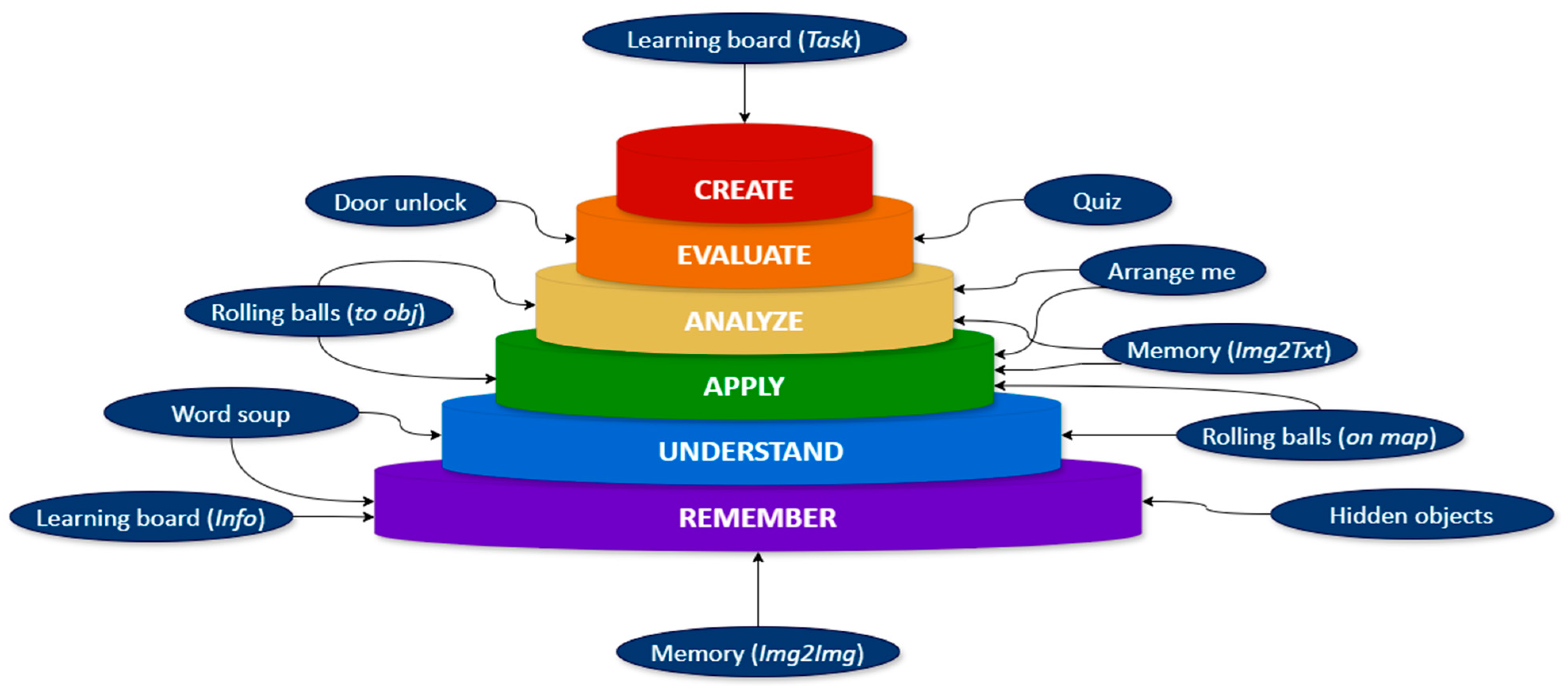
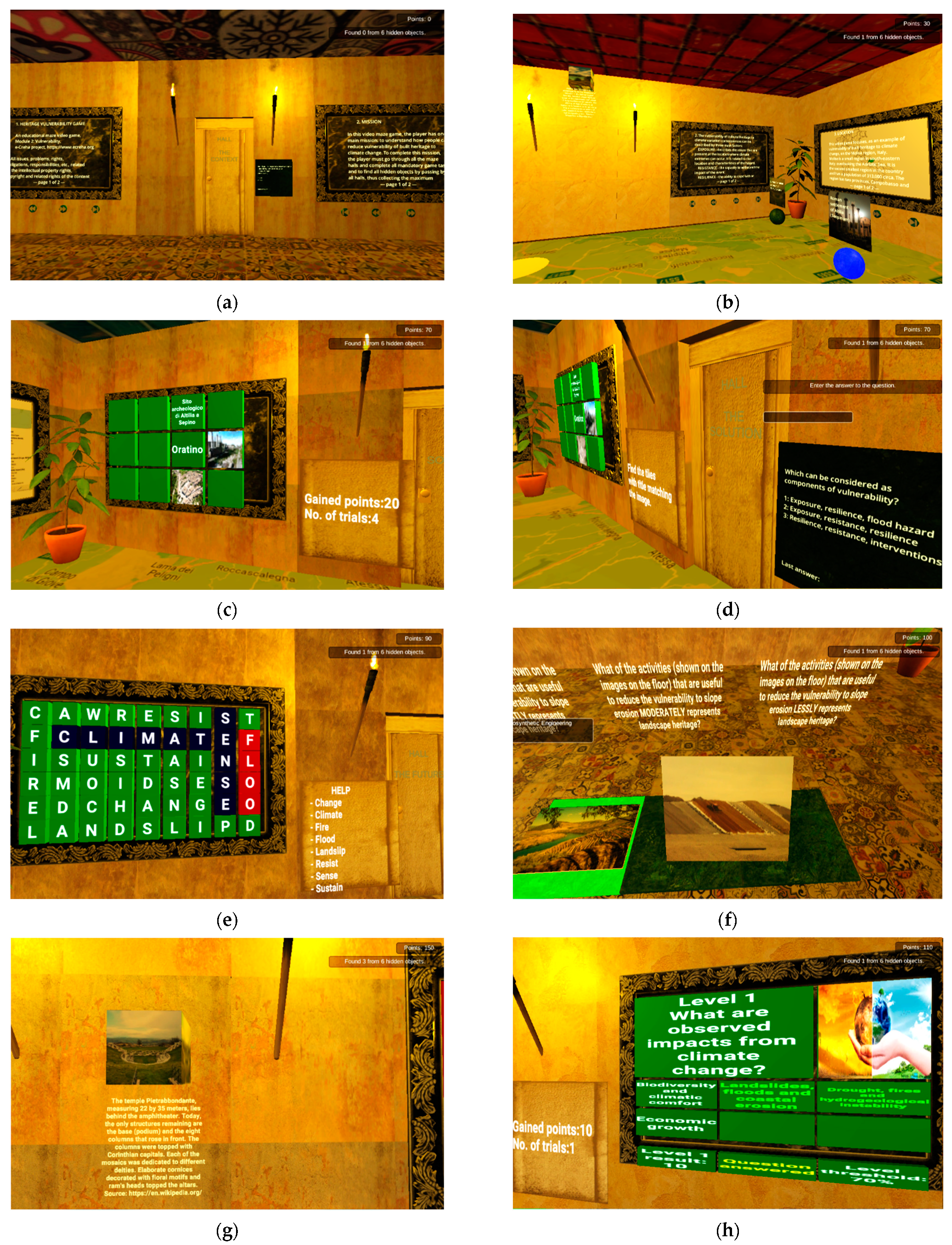
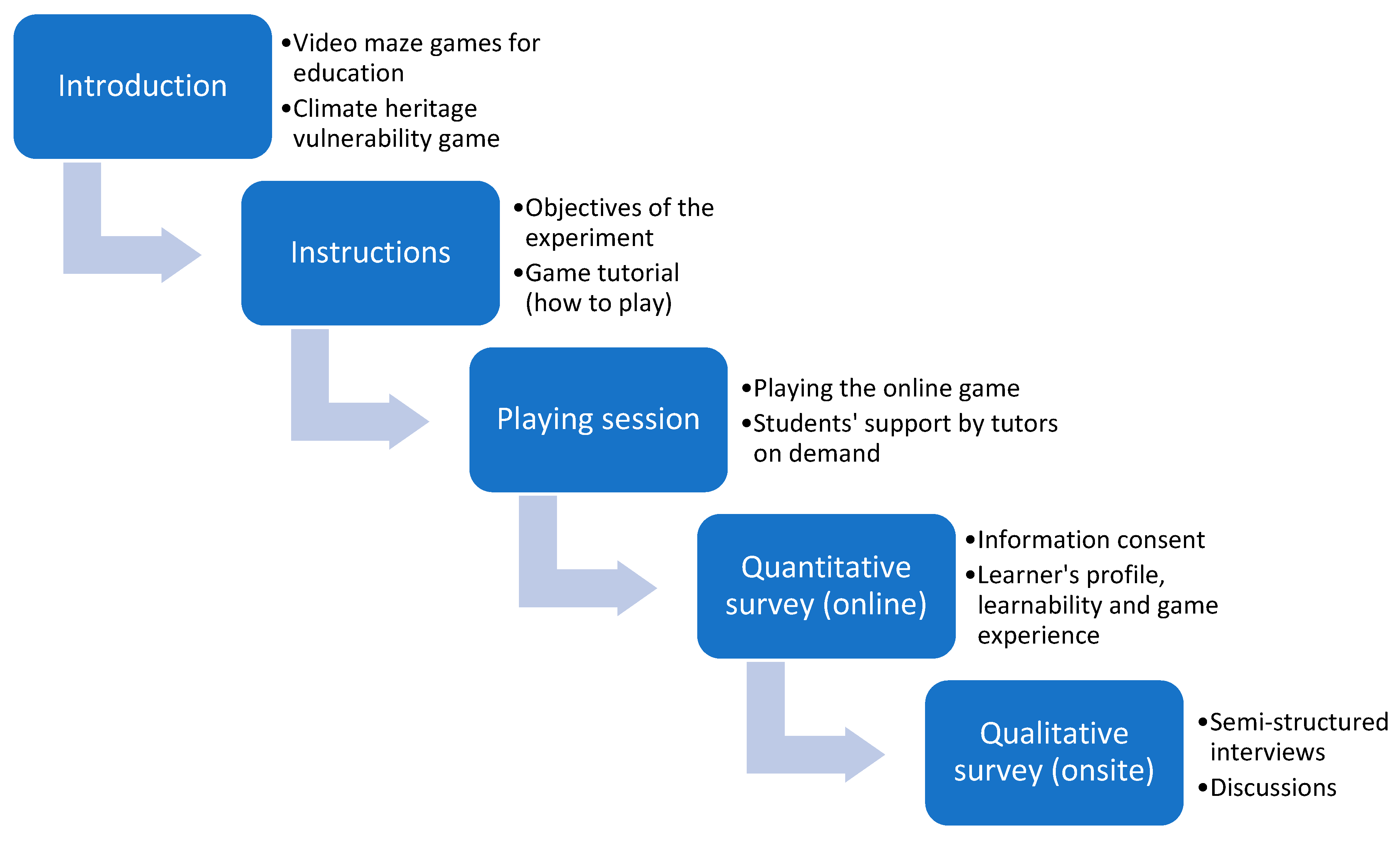
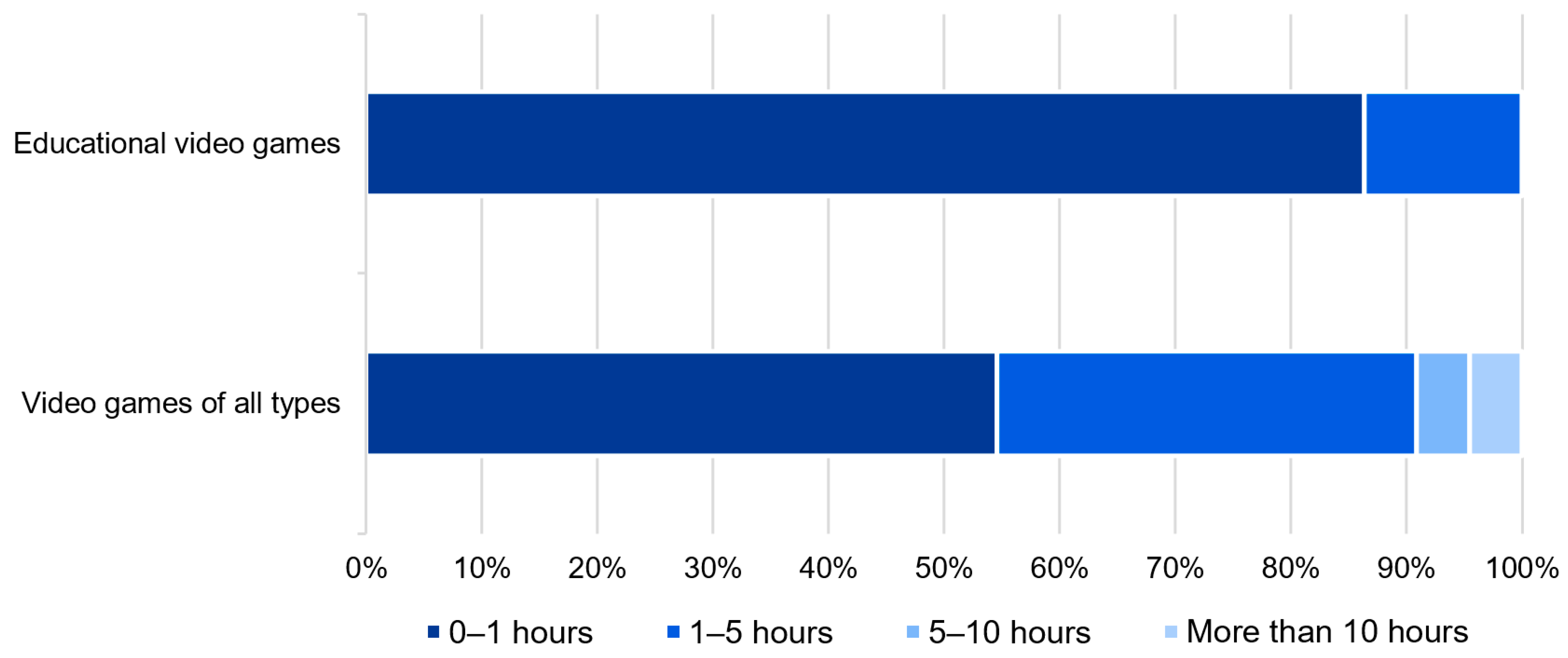

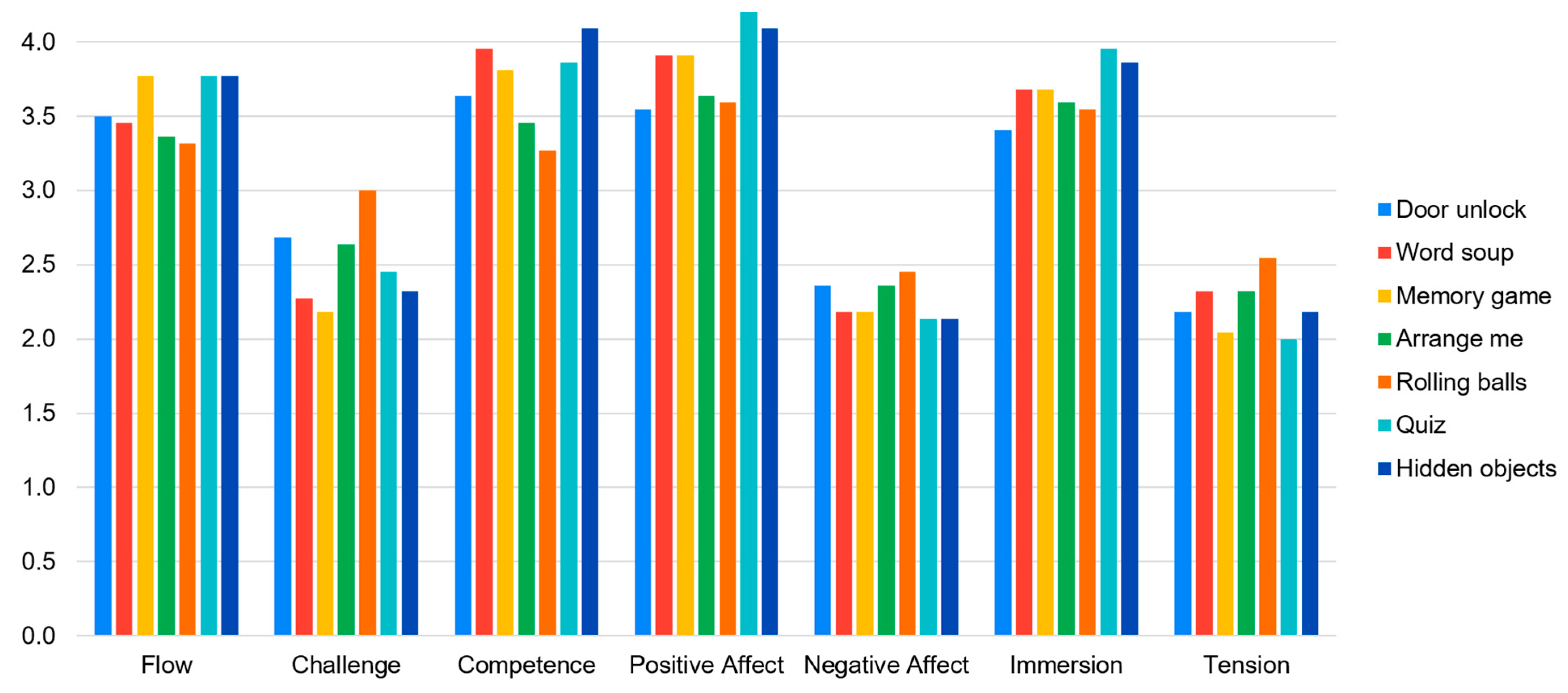

| Activity | Resilience Game | Vulnerability Game |
|---|---|---|
| Game design | User-centered design methodology; circular maze with 5 halls | User-centered maze design methodology; circular maze with 5 halls |
| Learning content design | Selection of content from documents suggested by domain specialists; 38 multi-slide learning boards | Active collaboration between game designers and domain specialists using shared templates; 39 multi-slide learning boards |
| Learning objects and mini-games design | No framework was applied; 5 types of mini-games with 8 game instances | The revised Bloom’s Taxonomy of learning outcomes was applied; 6 types of mini-games with 9 game instances |
| Formal description design | XML description of 771 lines used for automatic maze generation by the APOGEE platform | XML description of 746 lines used for automatic maze generation by the APOGEE platform |
| Multimedia design | 82 images and 5 audio resources | 75 images and 5 audio resources |
| Distribution design | An online video game accessible through a Web page (limited to workshop participants) | An online video game accessible through a Web page (limited to workshop participants) |
| Taxonomy Dimension | Dimension Definition | Application in the Maze Game |
|---|---|---|
| Create | Produce new, original work | Read the instructions on the learning boards about a specific task (e.g., read an additional learning resource) or a mini-game in the maze hall. |
| Evaluation | Justify a standpoint or decision | Select the correct answer(s) in the quiz game with various difficulty levels or answer questions to unlock the next hall. |
| Analyze | Draw connections among ideas | Arrange images in a time sequence or specific order; Compare images to textual descriptions to find the right match between image and text; Roll a ball to the correct 3D object. |
| Apply | Use the information in a new situation | Roll a ball to a 3D object with new contextual information; Arrange images according to new contextual descriptions; Mapping images to a textual description; Locate the correct position on a map and roll a ball with an appropriate textual description. |
| Understand | Explain ideas or concepts | Locate the correct position on a map and roll a ball with an appropriate textual description; Identify terms on the character table corresponding to specific definitions provided in the help. |
| Remember | Recall facts and basic concepts | Remember facts and concepts given at information learning boards or hidden 3D objects with metadata; Memorize them through memory game matching images; Remember terms as identify them on the character table. |
| Attribute | Ease of Learning | Familiarity | Consistency | Predictability | Informative Feedback | Error Handling | |
|---|---|---|---|---|---|---|---|
| Metrics | |||||||
| t-test (p-value) | 0.03926 | 0.18284 | 0.34356 | 0.36859 | 0.04365 | 0.17774 | |
| ∆M | 0.50974 | 0.19805 | 0.00325 | −0.22078 | 0.39935 | 0.37987 | |
| Pooled SD | 1.76831 | 1.45209 | 1.57259 | 1.29413 | 1.34415 | 1.39162 | |
| Cohen’s d | 0.28826 | 0.13639 | 0.00206 | −0.17060 | 0.29710 | 0.27297 | |
| Attribute | Ease of Learning | Familiarity | Consistency | Predictability | Informative Feedback | Error Handling | |
|---|---|---|---|---|---|---|---|
| Pearson r | |||||||
| Ease of Learning | 1 | ||||||
| Familiarity | 0.38711 | 1 | |||||
| Consistency | 0.36060 | 0.21252 | 1 | ||||
| Predictability | * 0.46427 | * 0.50374 | 0.17867 | 1 | |||
| Informative Feedback | * 0.43204 | 0.23372 | * 0.44618 | 0.41114 | 1 | ||
| Error Handling | −0.08573 | 0.17926 | −0.08025 | 0.07638 | −0.10367 | 1 | |
| Factors | Flow | Challenge | Competence | Positive Affect | Negative Affect | Immersion | Tension | |
|---|---|---|---|---|---|---|---|---|
| Metrics | ||||||||
| t-test (p-value) | 0.04895 | 0.03857 | 0.10035 | 0.04413 | 0.04008 | 0.16785 | 0.18849 | |
| ∆M | 0.33731 | −0.49816 | 0.26540 | 0.31014 | −0.35881 | 0.17179 | −0.15256 | |
| Pooled SD | 1.22843 | 1.34305 | 1.22164 | 1.19657 | 1.31819 | 1.25944 | 1.19877 | |
| Cohen’s d | 0.27459 | −0.37092 | 0.21725 | 0.25919 | −0.27220 | 0.13640 | −0.12726 | |
| Factors | Flow | Challenge | Competence | Positive Affect | Negative Affect | Immersion | Tension | |
|---|---|---|---|---|---|---|---|---|
| Pearson r | ||||||||
| Flow | 1 | |||||||
| Challenge | 0.21886 | 1 | ||||||
| Competence | ** 0.83690 | 0.26321 | 1 | |||||
| Positive Affect | ** 0.82530 | 0.19795 | ** 0.88843 | 1 | ||||
| Negative Affect | −0.04117 | * 0.61540 | 0.11159 | −0.00916 | 1 | |||
| Immersion | ** 0.88527 | 0.15200 | ** 0.78798 | ** 0.94277 | −0.15800 | 1 | ||
| Tension | 0.06524 | ** 0.82219 | 0.14890 | 0.10185 | ** 0.78561 | −0.01465 | 1 | |
Disclaimer/Publisher’s Note: The statements, opinions and data contained in all publications are solely those of the individual author(s) and contributor(s) and not of MDPI and/or the editor(s). MDPI and/or the editor(s) disclaim responsibility for any injury to people or property resulting from any ideas, methods, instructions or products referred to in the content. |
© 2024 by the authors. Licensee MDPI, Basel, Switzerland. This article is an open access article distributed under the terms and conditions of the Creative Commons Attribution (CC BY) license (https://creativecommons.org/licenses/by/4.0/).
Share and Cite
Bontchev, B.; Terzieva, V.; De Bonis, L.; Nocera, R.; Vassileva, D.; Ottaviano, G. Raising Awareness of Climate Heritage Resilience and Vulnerability by Playing Serious Video Games. Appl. Sci. 2025, 15, 21. https://doi.org/10.3390/app15010021
Bontchev B, Terzieva V, De Bonis L, Nocera R, Vassileva D, Ottaviano G. Raising Awareness of Climate Heritage Resilience and Vulnerability by Playing Serious Video Games. Applied Sciences. 2025; 15(1):21. https://doi.org/10.3390/app15010021
Chicago/Turabian StyleBontchev, Boyan, Valentina Terzieva, Luciano De Bonis, Rossella Nocera, Dessislava Vassileva, and Giovanni Ottaviano. 2025. "Raising Awareness of Climate Heritage Resilience and Vulnerability by Playing Serious Video Games" Applied Sciences 15, no. 1: 21. https://doi.org/10.3390/app15010021
APA StyleBontchev, B., Terzieva, V., De Bonis, L., Nocera, R., Vassileva, D., & Ottaviano, G. (2025). Raising Awareness of Climate Heritage Resilience and Vulnerability by Playing Serious Video Games. Applied Sciences, 15(1), 21. https://doi.org/10.3390/app15010021







